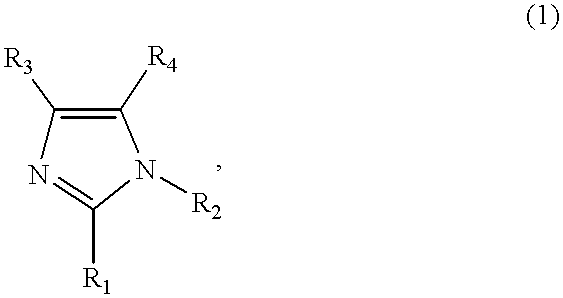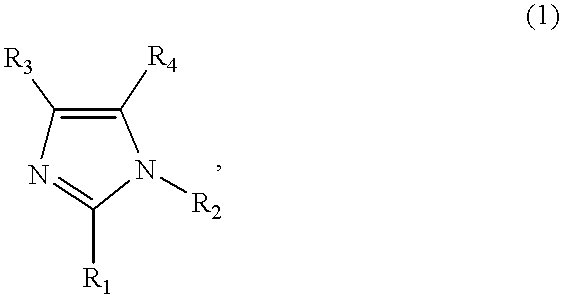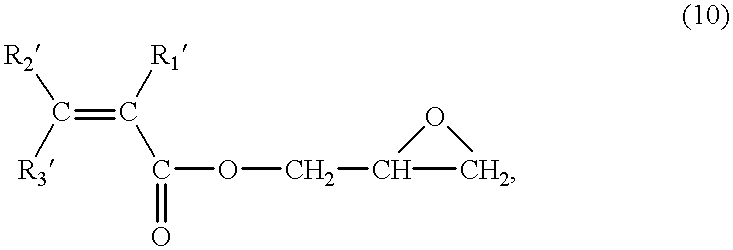In the heating roller fixation scheme frequently used heretofore, however, in order to obviate a fixation failure caused by a temperature change of the heating roller due to passage of fixation sheets and other external factors and also the so-called offset phenomenon of the toner being transferred onto the heating roller, it is necessary to maintain the heating roller within an optimum temperature range, thus requiring an increased
heat capacity of the heating roller which leads to a larger
power consumption, an increase in size of image forming apparatus and a temperature increase in the apparatus.
This method is very effective for the prevention of toner offset but requires a device for supplying the offset-preventing liquid, thus still involving a problem of requiring a complicated fixing device leading to an increase in size of the entire apparatus.
This is effective for offset prevention but on the other hand results in increased agglomeratability and unstable chargeability of the toner, thus being liable to cause a lowering in developing performance during continuous
image formation.
In the case of improving the anti-offset characteristic according to this method, however, the fixability is liable to be lowered while the developing performance is not so much adversely affected, thus resulting in lowering in fixability at low temperatures as required in high-speed fixation or economization of
energy consumption, i.e., inferior low-temperature fixability.
As is understood from the above, the low-temperature fixability and the anti-offset characteristic are contradictory in some respects, so that it is difficult to develop a toner simultaneously satisfying these properties.
However, in the case of using a crosslinked
vinyl polymer as a starting material for providing a toner containing such a component, the
polymer causes a very large
internal friction and receives a large shearing force during the melt-kneading stop for toner production.
For this reason, the molecular chains are severed in many cases to result in a toner having a lower melt-
viscosity, which adversely affects the anti-offset performance.
As a result, if these proposals are applied to production of a positively chargeable toner, the chargeability of the toner is liable to be impaired at the time of startup or
continuous operation or in a high-
humidity or low-
humidity environment, thus inviting lowering in developing performance leading to lower
image density and
fog.
Further, the agglomeratability is liable to be increased due to difficulty in stably retaining appropriate charges, thus causing difficulties, such as melt-sticking, cleaning failure and plugging in the cleaning step, and leakage spots.
Thus, they have not yet provided satisfactory results.
Further, the above proposals are effective in remarkably improving the balance among fixability, anti-offset characteristic and anti-blocking property, but the developing performance and the
mechanical strength of the
resultant toners are yet insufficient, and a room for improvement in continuous image forming performance, anti-offset property and anti-blocking property, has been left, when used in an electrophotographic apparatus of a large printing volume.
However, these positive
charge control agents are liable to have difficulties, such as insufficient chargeability to toner, or excessive or ununiform chargeability to toner leading to occurrence of blotches or increased toner agglomeratability, and lowering in developing performance such as
image density lowering and
fog, even if a sufficient charge can be provided to the toner.
Another difficulty is the occurrence of sleeve soiling caused by sticking of the
charge control agent liberated from the toner onto a sleeve as a developer-carrying member.
On the other hand, there is a problem as to how to stably retain an appropriate level of charge for a long period in the case of triboelectrically charging a toner in contact with a sleeve as a developer-carrying member.
However, in the case of using such a sleeve for triboelectrically charging a conventional positively chargeable toner using a
charge control agent, it is difficult to affect a toner charge control.
As a result, the opportunity of contact between the toner and the sleeve is decreased as a whole, so that appropriate charging is hindered, whereby there are liable to occur difficulties such as ununiform charges or excessive charge of toner resulting in blotches, thus naturally lowering the developing performances.
In the case of using an aluminum-made sleeve, a high charge-imparting ability to a positively chargeable toner is exhibited, but the sleeve is liable to be insufficient in durability because of the softness of the material and result in image deterioration due to surface wearing.
This provides a better durability due to an increased surface
hardness, but such coated aluminum sleeve have a lower charge-imparting ability to a positively chargeable toner in many cases than a stainless steel-made sleeve, thus being liable to cause toner charging failure.
A resin-coated sleeve is also known and exhibits good durability, but the charge-imparting ability thereof to toners is restricted.
More specifically, it is widely applicable for imparting negative charges but is liable to provide only insufficient level of positive charges, especially for a toner comprising an
acid group-containing binder resin.
In the cleaning step, it becomes possible to obviate difficulties, such as melt-sticking onto the photosensitive member and occurrence of leakage spots attributable to excessive toner charge, and melt-sticking, cleaning failure and toner plugging during conveyance due to agglomeratability and deterioration in flowability of toner due to agglomeratability and deterioration in flowability of the toner, and also plugging due to deterioration of conveyability.
Moreover, the toner is liable to cause the liberation of the charge control agent, which sticks onto the surface of a sleeve as a developer-carrying member, thus causing sleeve soiling.
It has been conventionally performed to effect a crosslinking reaction by using a carboxyl group unit and a
metal compound as crosslinking agents, but the
resultant crosslinked unit exhibits negative chargeability, thus obstructing the positive chargeability when used in a positively chargeable toner.
In case where the toner binder resin has an
acid value below 0.1 mgKOH / g, the resultant toner is liable to show a lower fixability, and lower effects of developing performance-stabilizing effect and sleeve soiling preventing effect owing to a reaction with the imidazole compound.
If the
acid value exceeds 50 mgKOH, the resultant positive chargeable toner is liable to have unstable developing performance in continuous
image formation due to a substantial negative chargeability of the binder resin.
In case where the THF-soluble content of the toner has an
acid value below 0.5 mgKOH / g, it becomes difficult to attain the effect of preventing soiling of heating members, such as a fixing roller, in some cases, and in excess of 30 mgKOH / g, the binder resin in the toner particles is caused to have a rather strong negative chargeability, thus being liable to result in a lower
image density and increased
fog, in the case of a positively chargeable toner.
If Mn exceeds 4.times.10.sup.4 or Mw exceeds 10.sup.7, it is difficult to attain a sufficiently improved fixability.
Above 40%, the realization of excellent fixability is liable to be difficult.
%, not only the fixability can be lowered but also the toner chargeability is liable to be ununiform.
If G' (80.degree. C.) is below 1.0.times.10.sup.5 Pa, the toner is liable to be thermally deformed easily at a low temperature region, so that the toner is liable to be deteriorated when an
internal temperature in an electrophotographic apparatus is increased, thus being liable to cause conveyance failure or
caking in the developing device or the cleaner.
If G' (140.degree. C.) exceeds 1.0.times.10.sup.4 Pa, the
thermal deformation of the toner can be insufficient to adversely affect the fixability.
If G' (140.degree. C.) is below 1.0.times.10.sup.3 Pa, the toner is liable to exhibit insufficient releasability, thus being liable to cause difficulties, such as offset, paper back soiling, winding, fixation claw trace, and fixing masher soiling.
If the temperature giving tan .
delta.=1 is below 90.degree. C. or tan .
delta. (80.degree. C.) is below 1, the contribution of irreversible deformation is liable to be lowered, thus adversely affecting the fixability.
On the other hand, if the temperature giving tan .
delta.=1 exceeds 130.degree. C. or tan .delta. (140.degree. C.) is larger than 1, the contribution of reversible deformation is liable to be lowered, thus lowering the releasability to adversely affect the anti-offset property and the peelability of transfer sheet from the fixing member.
 Login to View More
Login to View More 


